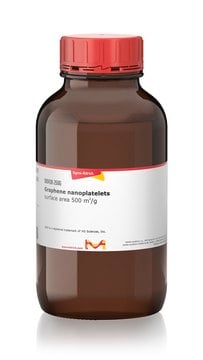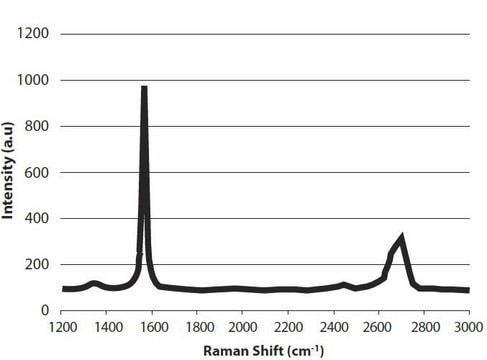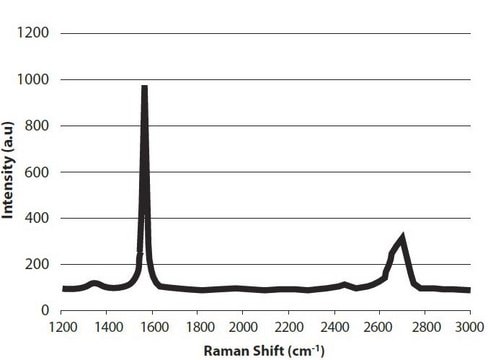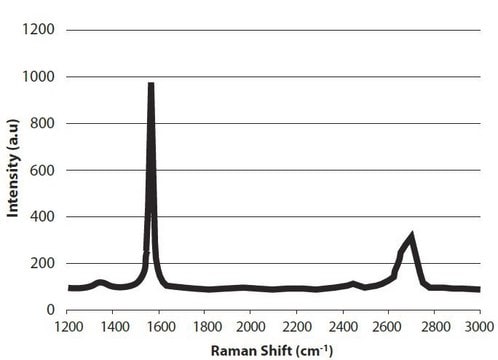Products may be shipped at a different temperature than the recommended long-term storage temperature. If the product quality is sensitive to short-term exposure to conditions other than the recommended long-term storage, it will be shipped on wet or dry-ice. If the product quality is NOT affected by short-term exposure to conditions other than the recommended long-term storage, it will be shipped at ambient temperature. As shipping routes are configured for minimum transit times, shipping at ambient temperature helps control shipping costs for our customers. For more information, please refer to the Storage and Transport Conditions document: https://www.sigmaaldrich.com/deepweb/assets/sigmaaldrich/marketing/global/documents/316/622/storage-transport-conditions-mk.pdf
900407
Graphene nanoplatelets
<2 μm particle size
Sinónimos:
GNPs, xGnP® graphene nanoplatelets-grade C-750
Seleccione un Tamaño
About This Item
Productos recomendados
descripción
relative gravity: 2.0-2.25 g/cm3
Nivel de calidad
Formulario
powder
superficie
750 m2/g
grosor
a few nm
tamaño de partícula
<2 μm
densidad aparente
0.2‑0.4 g/cm3
cadena SMILES
[C]
InChI
1S/C
Clave InChI
OKTJSMMVPCPJKN-UHFFFAOYSA-N
¿Está buscando productos similares? Visita Guía de comparación de productos
Categorías relacionadas
Descripción general
The unique size and platelet morphology of xGnP® graphene nanoplatelets makes these particles especially effective at providing barrier properties, while their pure graphitic composition makes them excellent electrical and thermal conductors. xGnP® graphene nanoplatelets can improve mechanical properties such as stiffness, strength, and surface hardness of the matrix material.
xGnP® graphene nanoplatelets are compatible with almost all polymers, and can be an active ingredient in inks or coatings as well as an excellent additive to plastics of all types. The unique manufacturing processes are non-oxidizing, so material has a pristine graphitic surface of sp2 carbon molecules that makes it especially suitable for applications requiring high electrical or thermal conductivity.
Grade C particles typically consist of aggregates of sub-micron platelets that have a particle diameter of less than 2 microns and a typical particle thickness of a few nanometers, depending on the surface area. In general, grade C particles show very high surface area and macro-porosity. Grade C particles are available in different grades with average surface areas of 300, 500 and 750 m2/g.
Aplicación
- Ultracapacitor electrodes.
- Anode materials for lithium-ion batteries.
- Conductive additive for battery electrodes.
- Electrically conductive inks.
- Thermally conductive films and coatings.
- Additive for lightweight composites.
- Films or coatings for EMI shielding.
- Substrate for chemical and biochemical sensors.
- Barrier material for packaging.
- Additive for super-strong concrete.
- Additive for metal-matrix composites.
Otras notas
Surface area of 750 m2/g is an average surface area.
Información legal
Código de clase de almacenamiento
11 - Combustible Solids
Clase de riesgo para el agua (WGK)
WGK 1
Punto de inflamabilidad (°F)
Not applicable
Punto de inflamabilidad (°C)
Not applicable
Elija entre una de las versiones más recientes:
¿Ya tiene este producto?
Encuentre la documentación para los productos que ha comprado recientemente en la Biblioteca de documentos.
Artículos
Advances in scalable synthesis and processing of two-dimensional materials
-
How is shipping temperature determined? And how is it related to the product storage temperature?
1 answer-
Helpful?
-
-
How can I determine the shelf life / expiration / retest date of this product?
1 answer-
If this product has an expiration or retest date, it will be shown on the Certificate of Analysis (COA, CofA). If there is no retest or expiration date listed on the product's COA, we do not have suitable stability data to determine a shelf life. For these products, the only date on the COA will be the release date; a retest, expiration, or use-by-date will not be displayed.
For all products, we recommend handling per defined conditions as printed in our product literature and website product descriptions. We recommend that products should be routinely inspected by customers to ensure they perform as expected.
For products without retest or expiration dates, our standard warranty of 1 year from the date of shipment is applicable.
For more information, please refer to the Product Dating Information document: https://www.sigmaaldrich.com/deepweb/assets/sigmaaldrich/marketing/global/documents/449/386/product-dating-information-mk.pdfHelpful?
-
Active Filters
Nuestro equipo de científicos tiene experiencia en todas las áreas de investigación: Ciencias de la vida, Ciencia de los materiales, Síntesis química, Cromatografía, Analítica y muchas otras.
Póngase en contacto con el Servicio técnico








